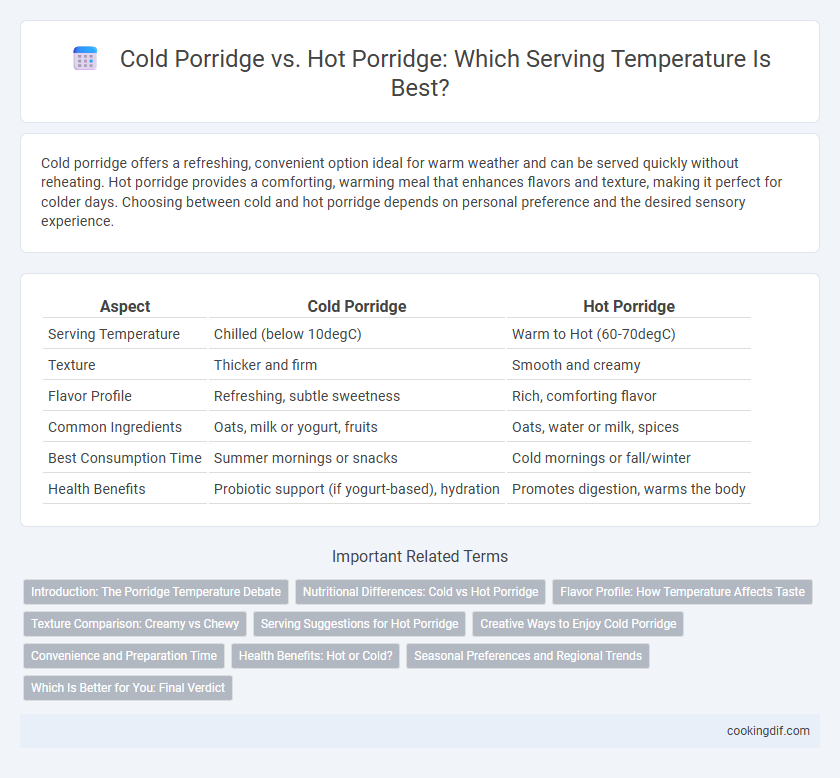Cold porridge offers a refreshing, convenient option ideal for warm weather and can be served quickly without reheating. Hot porridge provides a comforting, warming meal that enhances flavors and texture, making it perfect for colder days. Choosing between cold and hot porridge depends on personal preference and the desired sensory experience.
Table of Comparison
| Aspect | Cold Porridge | Hot Porridge |
|---|---|---|
| Serving Temperature | Chilled (below 10degC) | Warm to Hot (60-70degC) |
| Texture | Thicker and firm | Smooth and creamy |
| Flavor Profile | Refreshing, subtle sweetness | Rich, comforting flavor |
| Common Ingredients | Oats, milk or yogurt, fruits | Oats, water or milk, spices |
| Best Consumption Time | Summer mornings or snacks | Cold mornings or fall/winter |
| Health Benefits | Probiotic support (if yogurt-based), hydration | Promotes digestion, warms the body |
Introduction: The Porridge Temperature Debate
Cold porridge offers a refreshing and convenient option, often favored for its smooth texture and nutritional benefits when soaked overnight. Hot porridge provides warmth and comfort, enhancing flavors and making it a traditional choice for breakfast in colder climates. The debate centers on personal preference, nutritional impact, and cultural significance of serving temperature in porridge consumption.
Nutritional Differences: Cold vs Hot Porridge
Cold porridge retains more resistant starch compared to hot porridge, which enhances digestive health and promotes a lower glycemic response. Heating porridge breaks down some starches, leading to quicker carbohydrate absorption and higher blood sugar impacts. Therefore, cold porridge may offer better benefits for blood sugar control and gut health, while hot porridge provides faster energy release.
Flavor Profile: How Temperature Affects Taste
Cold porridge offers a denser texture and a mellow, slightly tangy flavor as the starches firm up and flavors intensify when chilled. Hot porridge enhances the creamy, comforting taste by releasing aromatic compounds and allowing subtle sweetness to emerge, creating a soothing meal experience. Temperature directly influences the sensory perception of porridge, altering its flavor complexity and mouthfeel.
Texture Comparison: Creamy vs Chewy
Cold porridge often develops a thicker, chewier texture due to starch retrogradation as it cools, creating a firm and slightly gelatinous consistency. Hot porridge maintains a creamy, smooth texture because the heat keeps the starches gelatinized and prevents them from setting. Serving temperature directly impacts porridge texture, with cold versions favored for a denser bite and hot porridge prized for its comforting creaminess.
Serving Suggestions for Hot Porridge
Hot porridge enhances flavors and offers a comforting, creamy texture that pairs well with toppings like fresh berries, honey, or cinnamon for optimal taste and nutritional absorption. Serving hot porridge immediately after cooking ensures optimal warmth and softness, making it ideal for a hearty breakfast that fuels the day. Incorporating warm ingredients such as nut butter or steamed fruits can further elevate the sensory and nutritional experience of hot porridge.
Creative Ways to Enjoy Cold Porridge
Cold porridge offers a refreshing alternative to the traditional hot serving, perfect for warm weather or on-the-go meals. Creative ways to enjoy cold porridge include layering it with fresh berries, nuts, chia seeds, and a drizzle of honey for a nutritious parfait, or blending it into smoothies for added fiber and creaminess. This chilled variation preserves the creamy texture while introducing new flavor possibilities and nutritional benefits.
Convenience and Preparation Time
Cold porridge offers convenience by requiring no cooking time, making it ideal for quick, on-the-go meals. Hot porridge demands more preparation time as it needs to be cooked or reheated, but provides a comforting, warm texture and enhanced flavor. Both options accommodate different dietary routines, with cold porridge often favored for its instant readiness and hot porridge appreciated for its traditional warmth.
Health Benefits: Hot or Cold?
Hot porridge enhances digestion by increasing enzyme activity and promoting nutrient absorption, while cold porridge retains more resistant starch, which supports gut health and improves blood sugar control. Eating hot porridge can soothe the digestive tract and provide immediate warmth, beneficial in cold climates or for recovery. Conversely, cold porridge offers probiotic benefits when fermented overnight, boosting gut microbiota and enhancing overall metabolic health.
Seasonal Preferences and Regional Trends
Cold porridge is favored in warmer seasons and regions with hot climates, offering a refreshing and easy-to-digest option rich in fiber and nutrients. Hot porridge remains popular in colder areas and during winter months, providing warming comfort and sustaining energy with its thick, creamy texture. Regional trends highlight Nordic countries embracing cold overnight oats, while the UK and parts of the US predominantly consume hot porridge for breakfast.
Which Is Better for You: Final Verdict
Cold porridge retains more resistant starch, which supports gut health and offers a lower glycemic index, making it beneficial for weight management and sustained energy release. Hot porridge provides easier digestion and quicker nutrient absorption, ideal for immediate energy and comfort during colder weather. Choosing between cold and hot porridge depends on individual health goals: cold for improved metabolic benefits and hot for rapid digestion and warmth.
Cold porridge vs hot porridge for serving temperature Infographic

 cookingdif.com
cookingdif.com